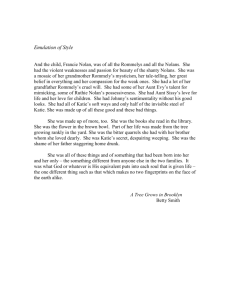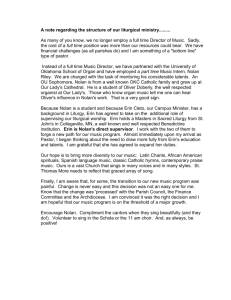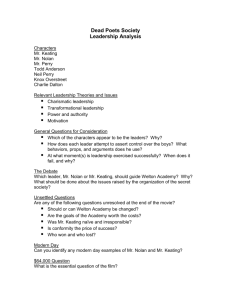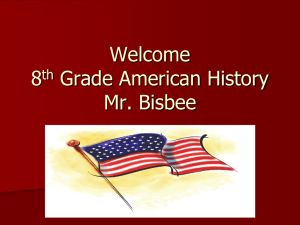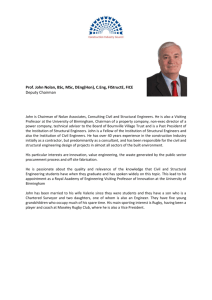Issue 21 - March 2011 - NolanFamilies.org Website
advertisement
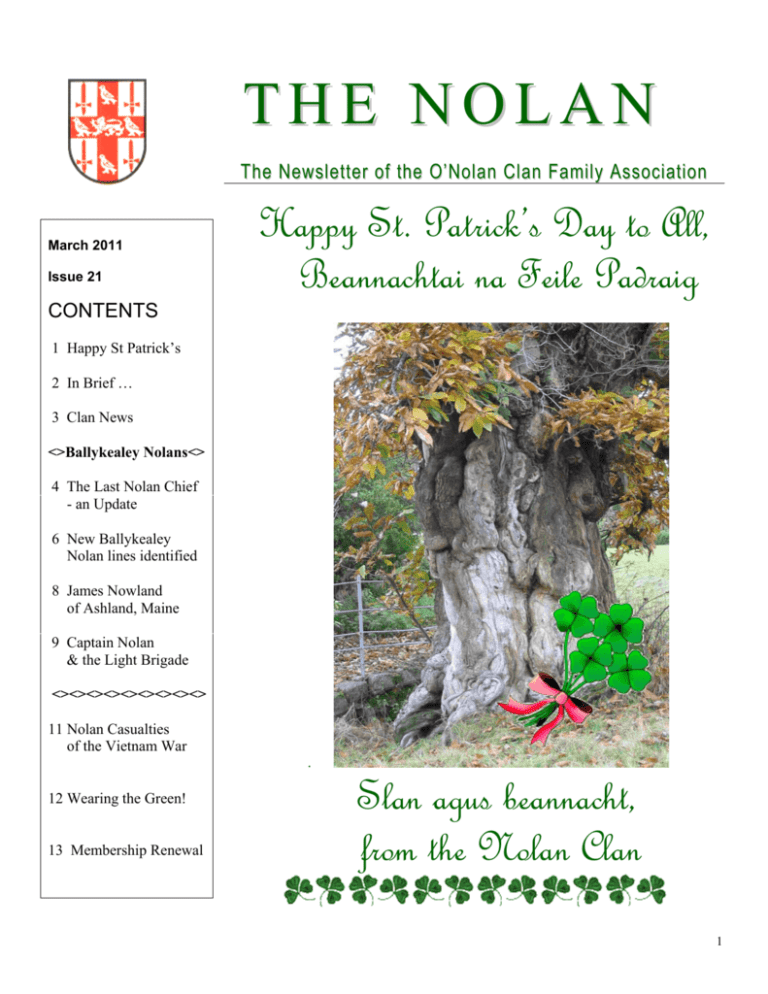
THE NOLAN The Newsletter of the O’Nolan Clan Family Association March 2011 Issue 21 Happy St. Patrick’s Day to All, Beannachtai na Feile Padraig CONTENTS 1 Happy St Patrick’s 2 In Brief … 3 Clan News <>Ballykealey Nolans<> 4 The Last Nolan Chief - an Update 6 New Ballykealey Nolan lines identified 8 James Nowland of Ashland, Maine 9 Captain Nolan & the Light Brigade <><><><><><><><><> 11 Nolan Casualties of the Vietnam War 12 Wearing the Green! 13 Membership Renewal . Slan agus beannacht, from the Nolan Clan 1 O’Nolan Clan Family Association Chief – Pa Nolan Mopoon Villa, Sydenham Road, Dundrum, Dublin 14 Republic of Ireland TEL: +353 (87) 243-8047 Email: panolan@ireland.com Tanaiste – Madeline Salter 1 Kilree St, Bagenalstown, Co. Carlow Republic of Ireland TEL: +353 (59) 97 22434 Email:msalter30@hotmail.com Secretary – Catherina O’Brien Ballytarsna, Nurney, Co. Carlow Republic of Ireland TEL: +44 (117) 9737992 Email: obrien@itcarlow.ie Treasurers & Membership – Sean & Mai Nolan Ardattin, Co. Carlow Republic of Ireland TEL: +353 (59) 91 55666 Newsletter Editor Roger Nowlan 222 Ave. De La Colline Gatineau, Quebec J9J 1T8 Canada TEL: +1 (819) 684-2535 FAX : +1(819) 684-6321 Email: RNowlan@primus.ca Letters, comments and articles of interest should be sent to the editor either by regular mail, by FAX or by E-Mail at the addresses listed above. Editorial views opinions expressed in publication are necessarily those of Clan association. and this not the In Brief … Clan News In this section I provide an update of Clan activities, especially as they relate to Clan Gatherings, and suggest that a review of Clan goals and objectives may be needed. I also introduce the concept of “tidbit” of information and suggest that, over time, it can help us to recover interesting stories about each of our individual family histories. A final bit of clan news is a birth announcement. The Last Nolan Chief – an Update In case you are wondering, the ancient tree appearing on the cover of the newsletter stands on the grounds of the Ballykealey estate, on the outskirts of Ballon Village in Co. Carlow, where, from time immemorial, generation upon generation of O’Nolan chiefs, lived, ruling over their ancestral homeland, Forth O’Nolan which today roughly corresponds to the modern territory of the Barony of Forth. Until recently, Cahir O’Nolan of Ballykealey, who died in 1592, was believed to have been the last chief of Forth O’Nolan recorded by name in the history books. However, the recent discovery of a Nolan chief, Peter Nowlan, who died in the mid-1700s, is opening up new lines of research for the prominent line of Ballykealey Nolans. New Ballykealey Nolan Lines In 2000 when the clan-sponsored Nolan history book was published the only identified line of Nolans known to have descended from the chief line of Ballykealey Nolans was the family to which Reverend Edward Nowlan, Bishop of Tullow, had belonged. Analysing the likely origins of the usage of Peter as a first name and recognizing that, in the mid-1600s, the “Nowland” spelling in Leinster was almost exclusive to the Ballykealey Nolans, I was able to identify several modern-day Nolan families likely to be descended from the Ballykealey Nolans. Several of these are briefly introduced in the first part of the Ballykealey section of the Newsletter. This is then followed by two feature articles, one on the family of Louis Edward Nolan of Light Brigade fame and one on that of James Nowland, an accountant, soldier and farmer who, in the mid-1800s, found his fortune in the American wilderness. Casualties in the Vietnam War One of our members, Dave Nolan, helps us to remember all the Nolans who served and died in the Vietnam War. March 17th -Wearing the Green! In an effort to better prepare us to celebrate, I provide an anonymous author’s reflections on the origins of the practice of “Wearing the Green” on St. Patrick’s Day. Membership Dues & Renewal Dues are due at the beginning of each calendar year and it is the responsibility of individual members to ensure that their membership is up-to-date. For the benefit of those who may not have paid their dues for this year, a mail-in form to be submitted with payment is attached at the end of the newsletter. Roger Nowlan Newsletter Editor 2 Clan News Clan Gatherings and Membership In 2010 a Clan Gathering had been planned for September 11th, however, due to insufficient clan members expressing an interest to attend, the Clan executive was forced to postpone the Gathering. The Clan organization remains committed to offering clan members the opportunity of meeting in Ireland every second year but, as has become apparent, numbers have to be there for it to be worth doing. Faced with dwindling membership, this may be a good time for the Clan organization to review its goals and objectives and how we set about achieving them. For my part, I remain committed to my role of putting out a Clan Newsletter at least once a year but, in the interest of all concerned, I invite you and any former members that you may know to share your ideas for the future of the Clan organization with any one of the clan executive members (see page 2 for contact particulars). If you have a “tidbit” of Nolan-related information which you would like to share with other modern-day Nolans and future generations, please do not be shy. ◊◊◊ Every “tidbit” counts! ◊◊◊ A Christmas Baby – Audrey born December 27th Michael Nowlan, a recent new member, and his wife Christiane Campbell of Ottawa, Canada, are pleased to announce the birth of their second child, Audrey Béatrice Campbell Nowlan, sister to Simon Bernhard, now 3 years old. In the midst of Christmas festivities, Audrey was born December 27th, weighing in at 9 pounds 3 ounces. Michael is the son of Roger and Rosie Nowlan of Gatineau, Quebec, long-time members of the Nolan Clan. Also, if you would like to attend a Clan gathering this year, now would be a good time to express your interest to any member of the executive. The Power of “Tidbits” of Information With the recent advances in connecting people together and the ability to search through more and more information, new and old, at ever increasing speeds, it is now becoming feasible to document individually-tailored family stories based upon “tidbits” of information gathered over time. In this issue of the Newsletter, the reader will observe in many of the stories presented how “tidbits” of information gathered over time do add up, revealing interesting and sometimes longforgotten stories. It is simply a matter of having patience and perseverance, not yours and mine alone but ours and that of future generations. That is the vision behind my personal website, the one hosting the Nolan Clan information (http://nolanfamilies.org). Audrey Béatrice Campbell Nowlan 3 The Last Nolan Chief – an Update by Roger Nowlan Introduction Based upon a Fitzgerald rent book, we know that in 1518, Murrough ‘ne dowre’ O’Nolan was “captain of his nation” (Forth O’Nolan). Also, from records of royal pardons for rebellious activity in the 1500s we are able to deduce that he had at least two sons, Edmund and Donough. The next recorded mention of a Nolan chief is in O’Flaherty’s book Ogygia (1598) wherein he mentions that the last O’Nolan proprietor and chief of the Barony of Forth had died a few years before. From other sources we know that this was Cahir O’Nolan of Ballykealey, son of Edmund, and grandson of Cahir, who died in 1592. Also, thanks to the efforts of family historians such as Fr. John Nolan, co-author of the clan-sponsored Nolan book (2000), we know that the family line of Bishop Edward Nolan (1793-1837) of Tullow is descended from Cahir O’Nolan of Ballykealey. Until recently that was pretty much the extent of our knowledge of this Chief family of Forth O’Nolan and, in this article, we will explore the repercussions of a recent discovery of who is now believed to have been the actual last Nolan Chief of Forth O’Nolan,dying in the mid-1700s. Peter Nowlan of Ballykealey Within the last year, via an Email posted to the Carlow genealogy list, it came to my attention that, in November 1744, a Peter Nowlan of BallyKealey had been arrested for treason and imprisoned in the Carlow jail (Ref: Pat Purcell Papers). Somewhat unusual, however, was the fact that several prominent Carlow individuals had witnessed this arrest (i.e. Bauchamp Bagenel Esq., Thomas Gurly Esq., Beaumont Astle Esq., Harcourt Pilsworth Lightburne Esq., and Hardy Eustace Esq.). Such importance attached to an arrest could only mean one thing. This was a person of some importance. Perusing through my collected “tidbits” of Nolan information I quickly realized that this could have been none other than the “chief of the O 'Nolans [who] lived at Ballykealey: the last of these chiefs hanged at Clonmel in 1745 on a charge of hightreason for his sympathy with the Jacobite Cause” (Ref: The Early Cullen Family, p188). I also knew that, in June 1726, a Captain Moses Nowlan had been “caught and tried in the Court of the King's Bench, for enlisting Wild Geese” in the service of the Spanish King. Found guilty, he had been hanged at the Irish Tyburn, near Stephen’s Green in Dublin”. Could he have been of the same family as Peter Nowlan of Ballykealey? Appealing to a couple more “tidbits” of previously collected information, I was able to make the link. I knew that a family of Nolans (Edward Nolan, Mary Eustace and children: Laughlin, Patrick, Martin, Thomas, James, John and Mary-Anne) had settled in Upper Canada in the early 1830s and that, in 1918, the eldest son, Laughlin, now known to have been born at Ballykealey in 1821, had told a reporter of the Peterborough Examiner that he was a first cousin to Captain Nolan of Light Brigade fame. The final “tidbit” which enabled me to make the link to Captain Moses Nowlan came from a reader of the Carlow Nationalist who, in 1921, after reading about Captain Nolan of Light Brigade fame in a recent issue of “The Freeman”, wrote in to remind readers that the Captain Nolan of Light Brigade fame “was of the same family of Kilkenny and Carlow soldiers as Captain Moses Nowlan , or O'Nowlan, who was a recruiting officer in Ireland for the armies of the King of Spain”. This earlier involvement of the Ballykealey Nolans in recruitment for foreign armies strongly suggests that, in 1744, when Peter Nowlan of Ballykealey, an officer in the Jacobite army, was arrested, he had been recruiting men in Ireland for the Irish Brigades of the French Army to be sent to Scotland in support of the Jacobite Rising of Bonnie Prince Charlie. The fact that Peter Nowlan was arrested in November 1744, the same month that Irish Regiments of the French Army arrived in Scotland provides strong support for this theory. 4 The First Name “Peter” The Butler-Nolan Friendship Develops At first, the discovery of a Nolan chief named Peter in the mid-1700s seemed a bit odd since, to my knowledge, this was the first Nolan chief to have used such a first name. This set me thinking about when in Nolan history the name Peter or a variant thereof might might have been first used by Nolans. The early 1500s were troubled times and, after centuries of fighting, the Gaelic lords, seeking to alleviate the hardships endured by their people, finally agreed to surrender their lands to the Crown and have them regranted under the terms of a Treaty of Peace signed in 1536 by the McMurrough, “principal captain of his nation” (Leinster) and Lord Grey, the king’s “Deputy” in Ireland. However, acceptance of land ownership also meant that land could be bought and sold, and soon open hostilities erupted between those who coveted the same lands. In Carlow, the two main parties seeking to acquire land were the Earl of Kildare (the Fitzgeralds) and the Earl of Ormonde (the Butlers). Upon reflection, I now believe that the answer lies in early Norman history in Ireland dating back to the mid-1400s. At that time, Sir James Butler of Paulstown [close to Carlow-|Kilkenny border], whose mother was Irish, learnt the Gaelic tongue and customs from a very early age and, in 1465, had a love affair with and eventually married Sabdh (Sabina) Kavanagh, widow of the O'Nolan chief and daughter of the then King of Leinster. Their son, Piers, better known as Piers Roe (the Red Piers), was, I believe, the initial inspiration for Nolan families beginning to use the first name Peter or a variant thererof. For those who may not know “Piers” is an early Norman spelling for the French first name Pierre which over time, in England and Ireland, took on various forms such Pierce or Pearce, or simply Peter, the English translation of Pierre. Piers Roe Butler (1467-1539) became the 8th Earl of Ormond, marrying Lady Margaret, daughter of Garrett More Fitzgerald, the then Governor of Ireland, and, by the time of his death, in 1539, Piers Roe himself had been named Governor of Ireland, not to mention also Earl of Ossory. In the mid-to-late 1700s, another source of inspiration for naming Nolan children Peter (or a variant thereof) may have been Pierce Butler (1744– 1822) of Ballintemple, Co. Carlow, one of America’s founding fathers. In this new environment of competion for land, the Nolan chief family seems to have sided with the Butlers who, by 1539, had wrested the governorship of Ireland from the Fitzgeralds and with whom they now shared family ties. This is reflected in O’Flaherty’s observation in his book Ogygia (1598) when he states that by then most of the former Nolan lands had become the property of the Earl of Ormonde (Butler family). Prime Areas of Association Based upon a knowledge of where descendants of the chief Nolan family and descendants of the Butlers of Paulstown are known to have lived, it is believed that the areas of greatest association between descendants of the two original families were Cloughrenan, Carlow town, Garryhunden, Tullow and Ballintemple in Co. Carlow, Paulstown, Gowran and Kilkenny city in Co. Kilkenny, and then possibly also Nenagh, Thurles and Fethard in Co. Tipperary. 5 New Ballykealey Nolan Lines Identified In light of the recent discovery of a Nolan chief named Peter Nowlan I present here the ancestral story for three modern-day Nolan families, who, in the past, have used the first name Peter (or a variant thereof) and are believed to descend from the Ballykealey Nolans. Pierce Nowland of Dublin One of America’s oldest Nolan family lines traces its ancestry back to Pierce Nowland, born in Dublin sometime around 1628. It is believed that this family’s roots were originally in the Carlow-Kilkenny border area around Paulstown but that, in the pursuit of business interests, the family, as most of the landed gentry class at the time, had, by the early 1600s, established for itself a “big house” in Dublin. During the course of the Irish Civil War which started in 1641, Pierce is believed to have gone to Fethard, a Royal Charter town and trade centre in southern Tipperary, where Piers Butler, a presumed distant cousin dating back to the mid-1400s, was Governor, not to mention one of the chief commanders for the Irish rebel forces. By 1650, the tide had turned against the Irish forces and, the King going into self-exile, the town of Fethard surrendered to Cromwell’s invading forces. Having taken an active part in the Irish civil war, under the terms of an Act of Resettlement passed in 1652, Piers Butler was forced to forfeit his vast lands in south Tipperary in exchange for less desirable lands in Connaught where he, his tenants and retainers could resettle. Around 1654, Pierce Nowland, believed to have been a tenant of Piers Butler and by then married with young children, was therefore obliged to relocate to Connaught, most likely settling in the Barony of Tyrawley in the north-eastern part of county Mayo where Piers Butler is known to have received lands in exchange for his confiscated lands in Tipperary. This is most likely where Pierce Jr., the one who would later immigrate to America, was born sometime around 1655. After the death of Cromwell in 1659 and the restoration of the monarchy in 1660, Piers Butler's family did regain some of its lands in county Tipperary, taking up residence in a former Grace castle in Ballylinch parish. At this point, Pierce Nowland, the defeated royalist rebel is believed to have returned to Co. Tipperary, settling in the area of Fethard. Evidence of this is found in the fact that Pierce Jr., his son who immigrated to America, named his land in Maryland "Fethard". At the time, it was a common practice for Irish immigrants to name the places where they settled after their place of origin in Ireland. Thomas Peter Nowland of Co. Antrim As a young man, Thomas had been sent to study for the priesthood in northern Ireland. However, one summer, while on vacation, as he and another novitiate worked in the fields, they were seized for military service and forced to work on a British fighting ship (Man of War). Only after 12 years, believed to have been around 1815, at the end of the Napoleonic Wars (1803-1815), was Thomas released from service. While still in the British Navy, Thomas married a Catherine Hamill of Co. Antrim and, sometime around 1809, they had a son named Peter. After his return to civilian life, Thomas settled with his family in northern Ireland in Co. Antrim and, sometime around the mid-1830s, his son Peter (1809-1861), immigrated to upper state New York where he married Catherine Keenan (1819-1905). After having settled in the area of Brasher Falls, NY, in 1837, a Charles Nowland, son of James Nowland of Hogansburg, NY, came to help him resettle and build a new home in Helena, NY. Charles’ father, James, hailed from Co. Carlow and, around 1815, had settled in the nearby area of Hogansburgh, NY. He is believed to have been Peter’s uncle, a brother of his father Thomas. Based upon military records of the day, there is reason to believe that, like Thomas, James had served in the British Navy but, having been captured during the War of 1812 and offered free land by the Americans, he had chosen to settle in America. 6 Strong evidence linking this Nowland family with the Ballykealey Nolans is found in the unique spelling of the family name “Nowland” which, on evidence, in the aftermath of the Cromwellian confiscations of the mid-1600s, seems to have been reserved, in Leinster, for use by the chief Nolan family of Ballykealey (ref: Garrett Nowland, leaseholder in 1666). Further evidence is found in the use of signature first names i.e. recurring first names found amongst descendants of the Ballykealey Nolans, names such as Charles, the English rendering of Cahir (honouring the memory of the Nolan chief Cahir O’Nolan), and William (honouring the memory of William the Marshall, “the greatest knight ever to live”). Bernard and Julia are other first names which, based upon my own observations, seem to have come into usage amongst the Ballykealey Nolans in the mid 1700s. The particular first names identified above are all found (underlined) in the list of children of Peter Nowland, the immigrant to America, and Catherine Keenan. The children’s names were: James (1839), John (1840), Agnes (1842), Charles (1845), Charlotte (1845), Elizabeth (1848), Charles (1850), Nancy (c1852), Bernard (c1856), Ellen (c1856), Catherine (c1858), William A. (c1860) and Julia (c1862). Thomas Nowlan of Ballon, Co. Carlow In 1827, a Thomas Nolan of Ballon, a businessman and wealthy farmer of Ballon Village, named “Rev. Peter Nowlan” of Carlow as executor for his will. This was likely the Reverend Peter Nowlan who served at Carlow’s Roman Catholic cathedral in the late 1700s and, as such, would have been of age to be a brother or cousin to Thomas. On June 12, 1832, Thomas died and, as per his will, his possessions were distributed to his five sons, Richard, Thomas, Patrick, Michael and John, while at the same time making provisions for his wife. Richard, probably the youngest, received Thomas’ leasehold on the lands held in Ballinadrum and owned by James Leckey. His inheritance also included bulloc cows, 2 horses and monies to be drawn from Thomas’ estate to pay for the construction of the “shell of a house” on the designated lands. Thomas Jr., probably the eldest, received Thomas’ leasehold on the lands held in Myshall and owned by Mr. Baggott [RN: probably Ballinrush since this was the only townland in Myshall owned by the Baggott family in 1851]. Thomas was also promised 300 pounds being held by Mr. Baggott but to be released within the next 3 years. In my opinion, the use of these signature first names coupled with the unique spelling of the family name i.e. “Nowland” make it almost certain that this family is descended from the Ballykealey Nolans. Patrick received Thomas’ leasehold on lands held in “Kiletheen” [RN: possibly Killane] and owned by James Leckey, 10 cows, 2 horses and the promise of 100 pounds then on loan to Michael, his brother, but which were to be paid within 4 years. The family’s association with northern Ireland is also interesting as it brings up another interesting question which I must leave to be explored sometime in the future, that is: “Was Fr. John Nolan, the original researcher of the Nolan book (2000), related to this family?” Michael received Thomas’ land, dwelling house and out offices in Ballon village, in addition to all “stock and merchandise” in the said house and offices. His inheritance, however, was subject to him paying an annuity of 10 Irish pounds for life to his mother, Thomas’ widow. We know that Fr. Nolan hailed from Northern Ireland and that both his father and a brother were named Peter. Most interesting to say the least! John received Thomas’ leasehold on lands and premises managed by “Representatives of the late Rev. James Conran”, lands held in “Garryonouge” and owned by James O’Brien, lands held in Cunnaberry and owned by the late Robert Marshall, as well as 14 cows, 2 horses and 100 Irish pounds to be paid to him by Michael, his brother. 7 James Nowland of Ashland – accountant, soldier & farmer James Nowland was born in Liverpool, England, in 1809 of Irish-born parents, James Martin Nowland, a quill dresser and feather merchant, and Catherine Boyle. As a young man he apprenticed as a bookkeeper in his native town of Liverpool and soon became an expert accountant. Around 1831, at the age of 22, he immigrated to New York with letters of introduction hoping to land a job with a large firm. However, due to a raging cholera epidemic at the time, he was forced to seek employment as a soldier. His regiment being ordered south he saw active service against the Seminole Indians. After the war, he was sent north and stationed in Houlton, Maine, where he remained until the expiration of his period of enlistment. After his discharge, James tried his hand at farming in the Houlton area, marrying a local girl sometime in the early 1840s and starting a family. By 1850, his wife had died and he was left with two young children, Susan, aged 7, and Emily, aged 5. The family had suffered greatly from the harsh winters and short harvests and, writing to his sister in Liverpool, Mary Ann married to a Reid, he told her of how he longed to sell his farm and to move out west. In 1850 he remarried, marrying someone named “Helen Augusta”, and finally decided to seek a bookkeeping job in St. John, NB, obtaining one without difficulty. Nonetheless, he made it known that he "always felt more independent on a farm until times got so bad that [he] could not live at all". In 1851, James and Augusta had their first child, Mary born in November of that year. Other children soon followed: Carrie in 1853, Alice in 1858 and James “Martin” in 1860. With the advent of the American Civil War (1860-1866), James, now an American citizen, was mustered into service on November 20, 1861. He served as an adjutant to the 15th Maine Infantry Regiment and, on September 11, 1863, resigned his post. That same year the family also moved away from St. John to a permanent residence in Ashland, Maine, raising livestock rather than potatoes and grain but still struggling for a livelihood. Living in Ashland, James still kept an eye on the Canadian political scene and, with the preConfederation promise of a railroad to unite the provinces of Upper and Lower Canada to the Atlantic Provinces, James recognized an opportunity to realize large profits for his family. In 1867, he submitted applications for land grants in New Brunswick for all his surviving children at that point, Martin, his only son, being the youngest and aged only 7 at the time. In July 1868, each of his six children was granted a 100 acre lot in the area of Harcourt, New Brunswick. Harcourt was a prime logging area and the prospect of being able to supply wood for the construction of the Canadian National Railway meant that they stood to make a handsome profit supplying wood to the railway or, eventually, to the whole of Canada, via the new railway being built. After their move to Ashland, Maine, James and Augusta had a further three children, Nellie born in 1865 but who had died by the time the land grant was made in 1867, Charles born the year the application was made and finally George born two years later in 1869. James and Augusta were Anglicans but appear to have had good relations with the Catholic community sending their youngest son, George, to attend a French Catholic high school in New Brunswick (Collège St. Joseph de Memramcook) for the school year 1890-1891. James’s father and James’ first son were both named James Martin, a combination of first names found in the Ballykealey Nolan line. In my opinion, the use by this family of the first name Martin and the unique spelling “Nowland” makes it highly likely that they were related to the Ballykealey Nolans. 8 Captain Louis Edward Nolan of Light Brigade Fame by Roger Nowlan Introduction Louis Edward Nolan (1818–1854), was a British Army officer, an authority on cavalry tactics best known for his controversial role in launching the disastrous “Charge of the Light Brigade” which resulted in the almost complete annihilation of a British Cavalry Division at Balaclava on the Crimean Peninsula in 1854. Much has been written about that fateful day in 1854 and, in this article, we will therefore limit our coverage of the events related to that infamous battle. Rather, we will focus on the origins of Louis’ family and, hopefully, in the process, gain a better understanding of the times in which Louis and his family lived. In England the Babingtons were remembered for their involvement in a thwarted attempt in the late 1500s to oust Elizabeth I and to replace her with Mary, Queen of the Scots, a Catholic. However, by the late 1700s, the Babington zeal for political change had mellowed somewhat. This new more peaceful approach was most fully realized in the person of Thomas Babington (1758–1837), an English philanthropist and politician, a member of the Clapham Sect, “a network of friends and families in England, with William Wilberforce as its centre of gravity, who were powerfully bound together by their shared moral and spiritual values, by their religious mission and social activism, by their love for each other, and by marriage [meeting regularly in the borough of Clapham near London]”. Growing up, “Babington-Nolan”, Louis’ grandfather would likely have been influenced by the morals and ideals of the Clapham sect. However, as the son of landed gentry, very early on he would also have been sent for military training. Marrying sometime around 1785, he is known to have had two children: a son, “John Babington Nolan”, born in Ireland sometime around 1786, and a daughter born sometime before his death in 1796. After being orphaned in 1796, John Babington and his sister were adopted by their father’s superior officer, General Francis Craig, a privilege normally reserved for the orphaned children of officers. At the General’s instigation, they also had the good fortune of obtaining a bounty from the Queen. Early Family History The earliest family record relates to Louis’ grandfather, a trooper in the 13th Light Dragoons who died of yellow fever on the island of Haiti in 1796. Known simply as “Babington-Nolan” he was no doubt the issue of a marriage between two landed gentry families, on the one hand the Babington family of Derbyshire and on the other a landed Nolan family of Ireland. In 1803, at the age of 17, young “Babington” was awarded an ensigncy in the 61st Regiment of Foot and the following year was appointed to a lieutenancy in the 70th Regiment of Foot. At this point in his life young Babington married for a first time, possibly in the West Indies, but his wife died in 1808. In 1812, after his service in the West Indies, he was promoted to the rank of Captain without purchase and assigned to the post of commander at the regiment’s depot in Perth, Scotland. 9 Assuming his new post in Perth, young Babington soon met Elizabeth Hartley who herself was already twice widowed and on the 12th of July 1813 they exchanged vows before an Episcopal minister. Eliza had previously been married to an Andrew Macfarlane and a Charles Ruddach and had two surviving sons: William Dick Macfarlane (1808) and George Elsy Ruddach (1810). Over the course of the next few years, except for a brief period spent in Upper Canada, Babington and Eliza stayed mostly in Scotland. This is reflected in the births of their four children: Louis’ Siblings Louis’ two surviving brothers never married and died relatively young. After his military training, Archibald Buchanan, the eldest, assumed the management of the Ruddach family’s Adelphi estate on the island of Tobago and died there in 1839, aged only 24. Edmond De Courcy, the youngest, similarly died quite young in 1843, at the age 23. At the time he was serving with the 6th Regiment of Foot in Kirkee, near Bombay, then part of British India. Louis’ Military Career • a son born in Perth, Scotland, in April 1814 but dying before 1818 • Archibald Buchanan, born in Edinburgh, Scotland in December 1815 • Louis Edward, born in York county, Upper Canada, in January 1818 • Edmond De Courcy, born in Edinburgh, Scotland, in 1820. Upon their return to Scotland in 1819, Babington and Eliza took up residence in an apartment at 79 Queen Street in Edinburgh and the following year, in February 1820, Babington retired from active military service, on half-pay. At this point we lose sight of the family only to pick up their trace again in 1829 when they were residing in Piacenza, Italy. Shortly thereafter the family moved on to Milan, then within the Austrian Empire. This is where, in 1832, Babington obtained an unsalaried position as British Consular Agent and Vice-Consul. Also in 1832 Archibald and Louis were sent for military training in Austria becoming cadets in King Friedrich Wilhelm’s 10th Regiment of Hussars. They trained at the Engineer Corps School in Tulln, Austria, and their younger brother, Edmond, joined them there 2 years later, although he was attached to another regiment. Through the family’s travels, by the time Louis entered military school in Austria in 1832, he had already become fluent in French, German and Italian. By the time he completed his training in 1835, he had added Hungarian to the list of languages he spoke (he later also learned several Indian languages). In the process Louis, or “Ludwig” as he had become affectionately known, had become an expert rider and swordsman and, upon graduation, was posted to his regiment, serving in Hungary and Poland and quickly rising through the ranks. By 1838, when he visited London for the coronation of Queen Victoria, aged only 20, he had already assumed the rank of Senior Lieutenant and, over the course of the following months, decided to join the British Army following in his father’s and grandfather’s footsteps. In 1839 Louis became a Cornet in the 15th King’s Hussars and, between then and that fateful day in 1854 when he died, most of his time, was spent serving in India, in Bangalore or Madras, or in England, at the regiment’s Cavalry Depot in Maidstone, Kent. Purchasing his Lieutenancy in 1841 and, impressing his superiors with his effective training of horses, in 1844 he was appointed Riding Master for his regiment and, over the course of the next few years, during extended leaves, researched and wrote two books on the use of horses: The Training of Cavalry Remount Horses: A New System, 1852, and; Cavalry: Its History and Tactics, 1853. 10 In March 1850, two months after his father’s death, he purchased a Captaincy. By 1854 when the Crimean War was raging Louis had already twice served as Aide-de-Camp (ADC) to Generals in India and the Ottoman Empire and this time was assigned to BrigadierGeneral Richard Airey, quartermaster-general to Lord Raglan, commander of the British Forces on the Crimean Peninsula. In the months leading up to the infamous battle of Balaclava, Louis had been tasked with supplying horses for the campaign and, travelling around Turkey, Lebanon and Syria, rounded up a total of 300 animals and, in July 1854, arrived with the horses in Varna, Bulgaria. From there he rejoined Brigadier-General Airey at the battlefront but soon expressed discontent at what he considered to be an inappropriate use of the cavalry forces in not pursing retreating forces. On that fateful day in Balaclava on the 25th of October 1854, from a hilltop vantage point, Lord Raglan and Brigadier-General Airey observed the battle unfolding below and, at one crucial juncture in the battle, Louis was sent to deliver to the commander of the Cavalry Division, Lord Cardigan, a now controversial “Fourth Order” for the Light Brigade to charge. An after-the-fact analysis of the events that day revealed that, after Louis had delivered the message to charge, the Cavalry headed in the wrong direction and, in an apparent attempt to head off the Cavalry, Louis had been hit by a piece of shrapnel from the first Russian artillery salvo. Thus ended the life of a valiant soldier, true to his calling and that of his forefathers. Nolan Family Casualties in the Vietnam War by Dave Nolan The Viet Nam War memorial in Washington, D.C. is a unique monument listing each of the 58,000 U.S. casualties who paid the ultimate price. Those honored in their death from 1967 through 1972 are: • Army Private Charles Albert Nolan Jr. (age 24) of Philadelphia, Pennsylvania • Army Lt. David Allen (age 25) of Minneapolis Minnesota • Army Captain Joseph Paul Nolan, Jr. (age 21) of Oak Point, Illinois, Civil Engineer • Michael Francis Nolan Jr. (age 23) of Schylerville, New York • Army Sergeant Peter Francis Nolan (age 21) of Madison, Wisconsin • Army Private Robert Frank Nolan (age 20) • U.S. Marine Lt. Commander Jerry Lynn Noland of Springfield, Massachusetts • Army Private Kenneth Eugene Noland (age 19) of Chester, Pennsylvania. 11 Why the wearing of the color green on Saint Patrick’s Day? Green, they say is the color of Ireland and Saint Patrick is the patron saint of this emerald isle. Maybe that is the reason, then again, maybe not. wore full green uniforms to make a political statement of strength and unity in the cause, “the wearing of the green”. Actually, wearing green as part of your Saint Patrick’s Day celebration is not really Irish. It is an “American thing”. In Ireland it does not have any major significance other than being the color of the shamrock which is significant in their history and perhaps that green is the color representing the Catholic segment of the Irish people, being that Saint Patrick’s Day is originally a Catholic Holy Day honoring Saint Patrick, that could be a reason though Saint Patrick was originally represented by the color blue. It wasn’t changed to green until much later in the history of this Holy Day of feasting, a break from the fasting of Lent. It is said that Ireland is the most lush and green land on the face of the Earth. Green is worn by the Irish-American in honor of the memory of the home of their fathers and forefathers, remembering Ireland, the Emerald Isle of their heritage. Saint Patrick came to Ireland from Scotland or from England (that is still being debated) to spread Christianity among the peoples who then inhabited the Emerald Isle. Those people were mostly Celtic by culture and religious beliefs. The Celtic peoples worshipped many a God and celebrated the Spring Solstice and the goddess Oastre (Eastre or Easter, Ishtar, several names apply). Saint Patrick’s Day, Easter and the Spring Solstice all approximate themselves in date. The Spring Solstice is a celebration of the lengthening day and warming of the sun’s rays as well as the greening fertility in nature …perhaps the color green was substituted and given a Christian slant to appease the new converts so they did not feel so estranged from their cultural upbringing and beliefs. Just a thought on my part. It has happened before and since. Green is the color of the shamrock, a plant that resembles the three leaf clover and it is said that Saint Patrick used the shamrock to explain the Trinity of God to the people of Ireland. The shamrock was also used to signify your support of the Irish Rebellion of 1798. Those who supported the rebellion were seen wearing a shamrock in their hat or lapel. It is from this that the saying “wearing of the green” originates. It was also at this time that on March 17th the Irish soldiers all The idea of wearing green may also come from the colors of the Flag of Ireland (three stripes, one green, one white and one orange). You wear green if you are Catholic, the legend being green represents the Catholic people, orange, the Protestant people and white, the color of unity and peace between them for their land. This may or may not have any factual basis as for centuries there has been rivalry between the two factions at times erupting into violence. It seems that the wearing of the green on Saint Patrick’s Day is simply a tradition that caught on and is still being carried on for many a reason but the one I like best is that green is the color of fertility in nature, the greening up of earth after a long winter season, spring’s arrival, life renewed as earth grows green and abundant again, wearing green, a salute to Mother Nature and the season. This smacks of having more of a Celtic origin than any connection with the faith and teachings of Saint Patrick but it certainly is Irish in origin and Ireland is very beautiful and green. Anyway you choose to look at it, the idea of wearing green on Saint Patrick’s Day is a tradition that probably will not die, not anytime soon and green is a very nice color. Green is a color associated with living things, our trees, grass, other plants, things we can’t live without. Green is a very good thing. By Anonymous (Source: http://socyberty.com/holidays /the-significance-of-the-wearing-of-the-green ) 12 I I wish to join/renew my membership in the O'Nolan Clan, a voluntary, non-profit organisation, relying upon its members for fund-raising, organizing clan activities and recruiting new members. I understand that membership is open to anyone who supports the goals and aspirations of the clan: • To organize a Clan Gathering every second year • To publish a Clan Newsletter at least once a year • To create and maintain, for current and future generations, an archive of historical and anecdotal information of interest to Nolans everywhere. I further understand that membership dues are to be paid upon joining and, thereafter at the beginning of each calendar year, prior to March 17th. To save on postage and service charges, I may choose to pay for more than one year at a time. I will also advise the Clan of any change of address. NOTE: Currently, the membership fee per household is set at 10 Euros, $13 USD, $15 CAD or $17 AUD depending upon whichever happens to be your local currency. If your currency is not one of the ones mentioned then the equivalent of 10 Euros in your currency must be calculated Enclosed is a personal cheque in my local currency made out to "Sean Nolan - Nolan Clan" in the amount of ___________ as payment for ______ year(s) membership in the clan. For clan records and to help with administration, my particulars (or revisions thereto) are: Name __________________________________________________________________________ Address ________________________________________________________________________ City_________________Co./State/Prov._____________Country/Postal/ZIPCode___________ Age_____Telephone No. __________________E-Mail Address__________________________ Other family members ___________________________________________________________ Indicate whether this is a new membership _____ or this is a renewal ______ Post To: Sean Nolan, Nolan Clan Treasurer Rathnarrin, Ardattin, Tullow, Co. Carlow, Republic of Ireland Tel: +353 5991 55666 13
